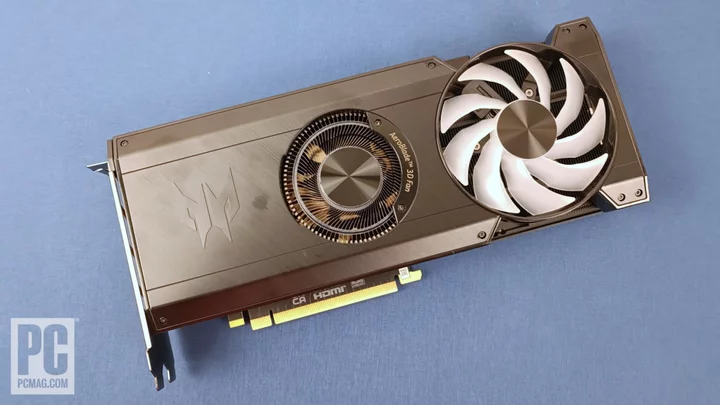Intel’s Arc graphics card line is one of the most exciting developments in a GPU world long dominated by AMD and Nvidia. Now, we look at one of Intel's manufacturing partners, Acer, to see how third parties are handling the firm's new dedicated graphics architecture. This is the Acer BiFrost Arc A770 OC graphics card, which was introduced at a price of $399.99 and has since fallen to $319.99. Based on the Intel Arc A770, this graphics card has true potential and performs well in select scenarios, but its performance can be inconsistent game to game due to Intel’s ongoing driver issues. This great-looking card has room to grow as drivers improve, but for more reliable, guaranteed gaming performance today, we recommend an Nvidia GeForce RTX 4060 or an AMD Radeon RX 7600.
Design and Configuration: Heimdall, AOpen the BiFrost!
When Intel launched its Arc graphics cards, the firm made clear that it intended to work with board partners just like AMD and Nvidia do. The first companies that we’ve seen put effort into producing cards for Intel have been ASRock and Acer. Both may seem like unconventional board partners, but they make a lot of sense.
(Credit: Michael Justin Allen Sexton)ASRock entered the market as a graphics card manufacturer for AMD just a few years back, but as AMD's newest partner, it likely had the most surplus capacity that it could contribute to the production of Intel cards. As for Acer, while these are the first “Acer” branded graphics cards we’ve seen, once upon a time Acer was actually a major maker of graphics cards under the brand name AOpen. Acer later refocused on its systems business, but now we see it taking the first steps back into graphics.
(Credit: Michael Justin Allen Sexton)Though Acer hasn’t produced commercial graphics cards for several years, this past experience as well as its time as a systems manufacturer make it arguably one of the most knowledgeable companies Intel could have partnered with that isn’t already too tied up with AMD or Nvidia.
(Credit: Michael Justin Allen Sexton)The Acer Predator BiFrost Intel Arc A770 OC card that Acer has produced reflects this experience, and the graphics card looks and feels well made overall. The card has a metal enclosure covering most of the top and back of the card with space cut out of it for air to pass into its two fans. One of these fans is larger than the other and actively vents inside of the case, whereas the smaller second fan works more in a blower configuration, venting hot air out the rear I/O panel.
(Credit: Michael Justin Allen Sexton)The thermal solution, like most of its kind, is predominantly built up out of an aluminum block. Four copper heatpipes run through the block and under the fans to help accelerate cooling of the GPU and memory chips underneath.
As an Arc A770, this card comes equipped with 512 vector engines that each contains eight unified shaders, which adds up to a total of 4,096 shaders. Then, you have 256 texture mapping units (TMUs), 128 ROPs, and 16MB of L2 cache alongside the vector engines. The card also contains 512 of Intel's Xe Matrix Extension Engines, which are capable of performing AI functions, as well as 32 ray-tracing units.
Acer set the Predator BiFrost Intel Arc A770 OC with a base clock of 2.2GHz, and the card has a limited ability to boost its clock speed in certain scenarios up to 2.4GHz. One area that Intel and Acer both went gangbusters on while developing this card is the video memory subsystem, which consists of 16GB of GDDR6 memory that supports a data rate of 17.5Gbps and connects to the GPU core over a 256-bit memory interface. This enables 560GBps of bandwidth between this RAM and the GPU core.
It should also be noted that the 16GB of memory on this card gives it one of the largest memory pools of any card in this price range. Most cards that compete head to head with the Arc A770 top out at just 8GB. You'll see some debate as to whether the Arc A770 can fully take advantage of this much memory, and I’d say that it cannot, but it can certainly use more than 8GB in some cases. Either way, this is one card you don’t need to worry over memory with.
(Credit: Michael Justin Allen Sexton)The card has a fairly standard configuration with one HDMI port and three DisplayPort jacks on its rear I/O panel. On the top edge, the card has two 8-pin power connectors giving it access to at least 375 watts (W) in total when the PCIe slot's power is included. Given Intel’s estimated 225W power draw of the Arc A770, this should mean an exceptional amount of power overhead for overclocking.
Software: Using the Acer Predator BiFrost Utility App
Acer is new again to the graphics card market, but it has no intention of doing things only half way. Most manufacturers develop their own software utilities to go along with their graphics cards, and even though Acer has very few cards to speak of at the moment, it has done the same. The Acer Predator BiFrost Utility app comes with everything you'd expect from a modern graphics card. This includes controls for adjusting the graphic card's RGB LED lights, its fans, and its clock speed.
(Credit: Acer)One particularly useful feature built into this app is the onscreen display function, which overlays the graphics card's real-time operating conditions over games. This enables you to see how the card is performing in terms of clock speeds, utilization, and operating temperature while you game, and this can be particularly useful when trying to fine-tune settings for the best experiences.
(Credit: Acer)Acer intends to ship a USB flash drive with its graphics cards, pre-filled with this software. A free flash drive is always a welcome bonus, but you can also download the software directly from Acer's website, which is likely the best idea as it ensures you have the most up-to-date version.
(Credit: Acer)Test Setup
All of the graphics cards shown in the charts below were tested on our 2022 graphics card test bed that is equipped with an Intel Core i9-12900K processor on an Asus ROG Maximus Z690 Hero motherboard. The processor is cooled by a 240mm Corsair Hydro Series H100x water cooler and operates at stock clock speeds. The system is loaded up with 32GB of Corsair Vengeance RAM clocked at 5,600MHz and a 1TB Corsair MP600 Pro NVMe PCIe 4.0 SSD that has Windows 11 Pro installed onto it. For power, the system is equipped with a Corsair HX1500i 1,500W power supply
The AMD Radeon RX 7600 and the Nvidia GeForce RTX 4060 are the main competitors for Intel's and Acer's Arc A770. Though you'll find several other cards that will challenge these three, they stand out as they are all in the newest generation for each manufacturer, they cost around the same, and each has its own advantages and disadvantages.
Straight away, the AMD Radeon RX 7600’s biggest advantage is that it costs just $269 compared with the Nvidia GeForce RTX 4060’s $299 price and the Arc A770’s current price of $319. Another key difference among the Arc A770 and these other two cards is memory. The Arc A770 has both double the amount of memory and double the memory interface of the RX 7600 and RTX 4060. This doesn't quite give it double the bandwidth, but close enough to it, and it will play a significant role in the following tests—especially at higher resolutions. We’ll discuss the advantages of these cards in more detail as we go over the test results below.
Synthetic Tests
Synthetic test results help us to gauge a graphics card's potential, but all of these results need to be taken with a pinch of salt as they may not accurately reflect real-world performance.
The Acer Predator BiFrost Intel Arc A770 OC performed impressively here by beating the Radeon RX 7600 and the GeForce RTX 4060 in all tests. At times, the Acer Arc A770 was able to surpass the Nvidia GeForce RTX 4060 Ti, too, which is exceptional given that card costs a fair bit more at $399 (given the BiFrost's street price at this writing).
Ray Tracing, FSR, DLSS, and XeSS Testing
Things continue to look rosy for the Acer Arc A770 when we look at tests that involve ray-tracing performance, too. In F1 22, it managed to maintain a healthy lead over the AMD Radeon RX 7600 and sat in a near tie with the GeForce RTX 4060. Enabling DLSS 2 for Nvidia and FSR 1.0 for AMD and Intel cards only heightened the Arc A770 further, giving it a clear advantage over the GeForce RTX 4060, too, and this changes little when DLSS 3 and FSR 2.0 are enabled.
In Returnal, we saw the Acer Predator BiFrost Intel Arc A770 OC take its first loss. Though it maintained a decisive lead over the Radeon RX 7600, the RTX 4060 surpassed it at 1080p and 1440p resolutions. At 4K, however, we again saw the Arc A770 on top. This is, in large part, thanks to the aforementioned difference in bandwidth, as the RTX 4060 simply doesn’t have the bandwidth to run this game well at 4K. Interestingly, in this test the Arc A770 even surpassed the Nvidia GeForce RTX 4060 Ti as it too is seriously bandwidth constrained.
Cyberpunk 2077 also returned mixed test results. The Radeon RX 7600 was once again unable to stand up to the Arc A770, but the RTX 4060 did better than expected. At 1440p, the RTX 4060 tied with the Arc A770, but at 1080p and 4K the Arc A770 was faster. Acer’s Arc A770 would have walked away the winner in this fight if not for DLSS 3, which helped the RTX 4060 to pull ahead with a major lead. The RTX 4060 Ti performed similarly here to the RTX 4060 against the Arc A770, also surpassing it at 1080p and 4K without DLSS enabled.
In our last test that supports ray tracing, Guardians of the Galaxy, the Arc A770 was not able to stand up to the Nvidia competition. It’s come to our attention through testing that this game tends to favor Nvidia cards, which is reflected by the Nvidia cards heavily dominating in this test.
AAA Game Tests
Ray-tracing performance appears to be one of Intel Arc's specialties, as the Acer Predator BiFrost Intel Arc A770 OC performed significantly worse in games that don’t support it compared with the competition.
In Total War: Three Kingdoms, the Acer Arc A770 managed only a slim lead over the Radeon RX 7600 and RTX 4060 at 4K resolutions. At 1080p, however, the Arc A770 was significantly slower than its main competitors, and performance at 1440p was a draw. Performance in Shadow of the Tomb Raider showed much the same results except the Arc A770 was slower at 1440p, too. The Arc A770 did worse in Far Cry 5 though, with it significantly behind the competition at all resolutions.
Legacy Game Tests
Typically, we test three older games with new graphics cards to gauge how well the new cards can run older games that don’t receive as much support anymore. This is one area that Intel has said it has put a great deal of effort into improving over the year, as Arc cards' performance at launch suffered noticeably in games that used older graphics APIs like DirectX 11.
We were interested to see how things had improved in this department, which is why we included Intel’s version of the Arc A770 here for comparison. We did not retest that card for this review but instead relied on the test results we got last year at the time of the Arc A770’s launch, as this should give us a rough idea of how much things have improved.
If anything, these results show things have gotten worse. In Bioshock Infinite, the Arc A770 was the slowest card tested at 1080p and 1440p, and it was even behind Intel’s version of the Arc A770 we tested last year. Hitman Absolution performance wasn’t any better with the Acer version of the Arc A770 with the latest graphics driver failing to finish the test at 1440p.
Likewise, we weren’t able to test with Sleeping Dogs, as the test crashed each time it was attempted. We encountered this issue with the Arc A770 last year too, so it's particularly disappointing to see this hasn’t improved at all.
System Power Consumption and Thermals
To test the power consumption of graphics cards, we use a Kill-A-Watt wall meter to measure the power pulled by our GPU test bed as a whole during select tests. The only part changed between tests was the graphics card in question, giving us a reasonable estimate of how much power it pulls relative to other cards we have tested.
The Arc A770 is a bit on the power-hungry side, consuming as much as 399 watts while running Guardians of the Galaxy. Intel’s idle power consumption issue also persists with this card pulling a considerable amount of power even while sitting at the desktop.
Typically, we use Furmark to help us measure the thermal performance of cards, but here too we had issues with the card that prevented us from doing so. Fortunately, we have other numbers we can use for comparison. We’ve been collecting thermal data and power consumption numbers from games in Returnal in preparation for making it a regular part of our testing procedures and have opted to roll this info out now to give us a glimpse at the card’s active thermal performance.
The Acer Arc A770 became quite hot while playing Returnal with a max temperature of 84 degrees C. Though this figure isn’t dangerous, it is higher than the competition and shows that either the Arc A770 GPU gets quite hot while in use or the thermal solution provided by Acer could use some improvement.
Given that the card was pulling as much as 419W during this test, however, we’d be willing to wager that it’s the GPU itself is simply getting quite hot. None of the other cards we’ve tested so far with Returnal used nearly as much power during the test.
(Credit: Michael Justin Allen Sexton)Verdict: On Second Thought, Keep the BiFrost Closed
Having spent some time with the Acer Predator BiFrost Intel Arc A770 OC, we are left with the impression that Acer still has what it takes to make a high-performance graphics card. Even with the Arc A770 GPU being relatively power-hungry, the card never reached unsafe temperatures even though it only uses a dual-fan, dual-slot thermal solution.
The graphics card also feels and looks like a well-made premium device, and we’d love to give it a better score for that. Indeed, we gave the original A770 a 3.5-star score, but given relatively slow pace of progress almost a year after launch, the BiFrost gets dragged down by the software-drivers anchor.
(Credit: Michael Justin Allen Sexton)The card is quality in build, but the performance of Intel’s Arc A770 graphics chip is still far from what we’d like to see. In select tests, the card performed exceptionally well and easily beat its main competition, but its performance is anything but consistent. Performance in other tests was significantly lower than expected and some tests completely failed to run.
We were enthusiastic about the launch of Intel’s Arc A770 but, nearly one year after launch, we would have liked to see some even bigger improvements made to the card’s drivers to bring better compatibility and more consistent performance numbers across the board. That hasn’t quite happened yet, and that makes it hard for us to recommend any Arc A770, even one as well-made as Acer’s Predator BiFrost Intel Arc A770 OC.









